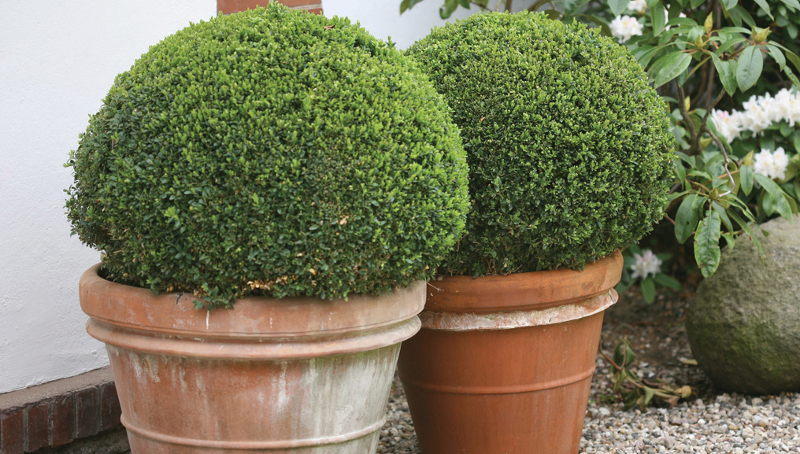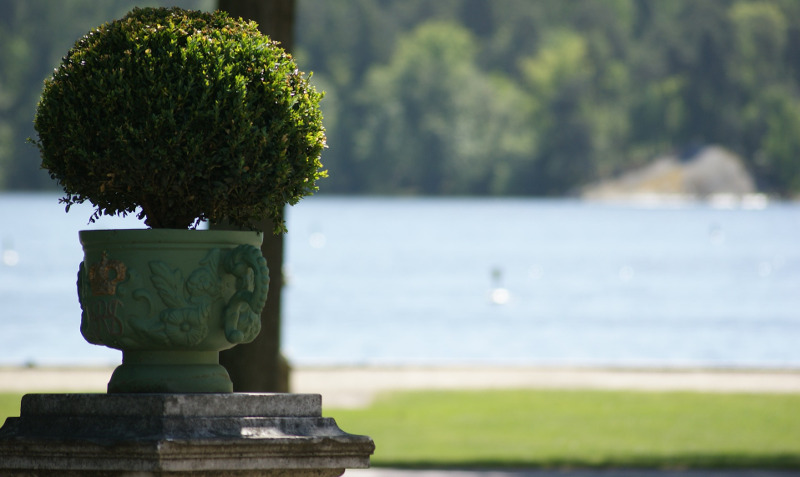Evergreen boxwoods give you year-round color, and what better place to have a live this pretty green shrub than in a featured pot? Even better, a trimmed boxwood in one or more containers gives your garden a living sculpture to enjoy all year. And boxwoods are easy to care for, even when you grow them in containers.

Plenty of boxwood varieties make great potted plants. For example, Sprinter Boxwood (Buxus microphylla 'Bulthouse') is a perfect container boxwood, growing to about 2 to 4 feet tall and wide. Wedding Ring (B. microphylla var. koreana) has glossy foliage that grows no higher or wider than about 3 feet. Green Mound is hybrid with a natural rounded shape for your large containers.
Boxwoods look great as the sole plant in a container or providing height and a backdrop for flowering annuals. These flexible little shrubs look beautiful in single decorative pots, but even better when paired or teamed up to frame an entryway or line an area of your garden or patio. Plant multiple matching pots filled with matching boxwoods in an evenly spaced line to mark your walkway or driveway. Line the patio edge with evergreen boxwoods you can see from your kitchen window when the winter lawn is bare. Use taller containers for height or add an accent color while keeping an ordered appearance in a formal area.
Choosing a Container For Boxwoods
You can grow boxwoods in nearly any container, provided the pots have two features: First, the container must be larger in diameter than the root ball of the boxwood you choose. That is easy to tell by measuring the container your boxwood comes in or setting it down into your decorative pot. In general, go with a width and height at least the size of the mature boxwood, and preferably a little larger. This gives the shrub's roots some room to grow. Just tuck loose potting mix around the root ball to fill the container.

The other consideration is good drainage. Any container you choose needs an excellent drainage hole – or you need to carefully drill a few. Boxwoods do not like to sit in wet roots, so this step is critical.
Other than making sure you have enough room and good drainage, get creative with your containers. If you want a particular height, add the expected mature size of the boxwood you choose to that of your container. Go with a formal look or a bright color, maybe a unique shape.
Caring For Boxwood in Planters
Pots dry out more quickly than the ground, especially if they are made of clay (terracotta). So, even though a mature boxwood is drought tolerant, the ones you grow in pots likely need more frequent watering than any you grow in the ground. Don't try to catch up all at once on your watering; a heavy, strong flow of water can wash many of the soil's nutrients out with the extra water. Try to water moderately, just until you see dripping at the bottom of the container, about once a week in summer.
In addition, containers can get colder than the ground in winter, so make sure you select a boxwood hardy to your zone or a little colder, just to be sure. Cut back on watering in the winter but give your boxwood some water if it does not receive snow or rain.

Each spring, when you prune, add an inch-thick layer of compost to the top of the soil and work it in gently. This replaces nutrients that might have washed out of the container. Eventually, you might have to repot a boxwood, but it depends on the variety you choose and size of the container. A rule of thumb is three years if you notice its growth slowing. Loosen or trim the roots before potting your boxwood into a new container.
 |
Author Teresa Odle - Published 8-28-2019 |
